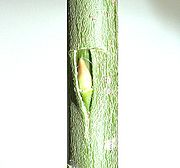
Shield budding
Encyclopedia

Grafting
Grafting is a horticultural technique whereby tissues from one plant are inserted into those of another so that the two sets of vascular tissues may join together. This vascular joining is called inosculation...
to change varieties of fruit tree
Fruit tree
A fruit tree is a tree which bears fruit that is consumed or used by people — all trees that are flowering plants produce fruit, which are the ripened ovaries of flowers containing one or more seeds. In horticultural usage, the term 'fruit tree' is limited to those that provide fruit for...
s. Typically used in fruit tree propagation
Fruit tree propagation
Fruit tree propagation is usually carried out through asexual reproduction by grafting or budding the desired variety onto a suitable rootstock.Perennial plants can be propagated either by sexual or vegetative means...
, it can also be used for many other kinds of nursery
Nursery (horticulture)
A nursery is a place where plants are propagated and grown to usable size. They include retail nurseries which sell to the general public, wholesale nurseries which sell only to businesses such as other nurseries and to commercial gardeners, and private nurseries which supply the needs of...
stock. An extremely sharp knife is necessary; specialty budding knives are on the market. The rootstock or stock plant may be cut off above the bud at budding, or one may wait until it is certain that the bud is growing.
Fruit tree budding is done when the bark
Bark
Bark is the outermost layers of stems and roots of woody plants. Plants with bark include trees, woody vines and shrubs. Bark refers to all the tissues outside of the vascular cambium and is a nontechnical term. It overlays the wood and consists of the inner bark and the outer bark. The inner...
"slips," i.e. the cambium
Cambium (botany)
A cambium , in botany, is a tissue layer that provide undifferentiated cells for plant growth. It forms parallel rows of cells, which result in secondary tissues....
is moist and actively growing. Rootstocks are young trees, either seedlings as Mazzard cherries for many cherry
Cherry
The cherry is the fruit of many plants of the genus Prunus, and is a fleshy stone fruit. The cherry fruits of commerce are usually obtained from a limited number of species, including especially cultivars of the wild cherry, Prunus avium....
varieties, or clonal rootstocks (usually propagated by layering) when one wants highly consistent plants with well defined characteristics. The popular Malling-Merton series of rootstocks for apple
Apple
The apple is the pomaceous fruit of the apple tree, species Malus domestica in the rose family . It is one of the most widely cultivated tree fruits, and the most widely known of the many members of genus Malus that are used by humans. Apple grow on small, deciduous trees that blossom in the spring...
s was developed in England
England
England is a country that is part of the United Kingdom. It shares land borders with Scotland to the north and Wales to the west; the Irish Sea is to the north west, the Celtic Sea to the south west, with the North Sea to the east and the English Channel to the south separating it from continental...
, and are used today for the majority of the commercial apple orchard trees.
T-budding is the most common style, whereby a T-shaped slit is made in the stock plant, and the knife is flexed from side to side in the lower slit to loosen up the bark. Scion
Grafting
Grafting is a horticultural technique whereby tissues from one plant are inserted into those of another so that the two sets of vascular tissues may join together. This vascular joining is called inosculation...
wood is selected from the chosen variety, as young, actively growing shoots. Usually, buds at the tip, or at the older parts of the shoot are discarded, and only two to four buds are taken for use. The buds are in the leaf
Leaf
A leaf is an organ of a vascular plant, as defined in botanical terms, and in particular in plant morphology. Foliage is a mass noun that refers to leaves as a feature of plants....
axils. They may be so tiny as to be almost unnoticeable.
Holding the petiole of the leaf as a handle, an oval of the main stem is sliced off, including the petiole and the bud. This is immediately slid into the T on the rootstock, before it can dry out. The joined bud and rootstock are held by a winding of rubber band, which will hold it until sealed, but the band will deteriorate in the sunlight so it soon breaks and does not pinch new growth, girdling the shoot.
The percentage of "take" of the buds depends on the natural compatibility of the stock and scion, the sharpness of the knife, and the skill of the budder; even the experts will have some buds die.

